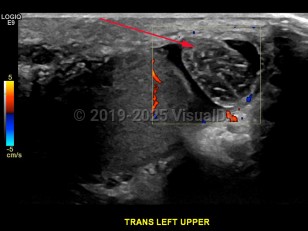Emergency: requires immediate attention
Testicular torsion
Alerts and Notices
Important News & Links
Synopsis

Testicular torsion is a medical emergency that results in a twisted spermatic cord and compromised blood flow to the testes with irreversible damage occurring in as little as 6 hours. A twisted spermatic cord initially results in lymphatic obstruction and then progresses to increased venous pressure, venous congestion, and ultimately decreased arterial flow leading to testicle ischemia and necrosis.
The main presenting symptoms are rapid onset of scrotal pain and swelling, often accompanied by nausea and vomiting. The patient may also complain of abdominal or pelvic pain, dysuria, fever, and an altered gait. Typically, testicular torsion occurs unilaterally, and patients may report previous episodes of similar scrotal pain that resolved spontaneously. Testicular torsion occurs most often in patients under the age of 20, although it can occur at any age with peaks occurring in neonates and during puberty. It is the leading cause of testicular loss.
Risk factors for testicular torsion include a bell clapper deformity that allows for increased movement of the testicle in relation to the spermatic cord within the tunica vaginalis. This deformity is often bilateral. Trauma or vigorous physical activity may result in testicular torsion. A family or prior personal history of testicle torsion are also risk factors.
Physical examination will show a raised testicle and absent cremasteric reflex. The testicle is often swollen and tender with an abnormal lie. Scrotal edema and tenderness may also be present, although the condition may be painless in approximately 10% of affected patients. The scrotum may also appear reddened or darkened on the affected side.
Emergency surgery for detorsion of the spermatic cord is required.
The main presenting symptoms are rapid onset of scrotal pain and swelling, often accompanied by nausea and vomiting. The patient may also complain of abdominal or pelvic pain, dysuria, fever, and an altered gait. Typically, testicular torsion occurs unilaterally, and patients may report previous episodes of similar scrotal pain that resolved spontaneously. Testicular torsion occurs most often in patients under the age of 20, although it can occur at any age with peaks occurring in neonates and during puberty. It is the leading cause of testicular loss.
Risk factors for testicular torsion include a bell clapper deformity that allows for increased movement of the testicle in relation to the spermatic cord within the tunica vaginalis. This deformity is often bilateral. Trauma or vigorous physical activity may result in testicular torsion. A family or prior personal history of testicle torsion are also risk factors.
Physical examination will show a raised testicle and absent cremasteric reflex. The testicle is often swollen and tender with an abnormal lie. Scrotal edema and tenderness may also be present, although the condition may be painless in approximately 10% of affected patients. The scrotum may also appear reddened or darkened on the affected side.
Emergency surgery for detorsion of the spermatic cord is required.
Codes
ICD10CM:
N44.00 – Torsion of testis, unspecified
SNOMEDCT:
81996005 – Torsion of testis
N44.00 – Torsion of testis, unspecified
SNOMEDCT:
81996005 – Torsion of testis
Look For
Subscription Required
Diagnostic Pearls
Subscription Required
Differential Diagnosis & Pitfalls

To perform a comparison, select diagnoses from the classic differential
Subscription Required
Best Tests
Subscription Required
Management Pearls
Subscription Required
Therapy
Subscription Required
References
Subscription Required
Last Reviewed:01/18/2018
Last Updated:01/18/2018
Last Updated:01/18/2018
Emergency: requires immediate attention
Testicular torsion

